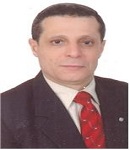Day 1 :
- Track 3: Pharmacognosy, Pharmaceutical Chemistry and Phytochemistry
Track 4: Pharmacological Sciences
Track 5: Genetics, Genetic Engineering and Biomedical Engineering
Location: Melia Valencia Palacio De Congresos
Session Introduction
Djebbar Atmani
University of Bejaia, Algeria
Title: Effect of Fraxinus angustifolia (Oleacea) leaf and bark extracts on acute and chronic inflammation: enhanced activity of nanovesicle-trapped extracts

Biography:
Professor Djebbar Atmani has completed his Master of Science degree at California State University, Los Angeles (USA) in 1987 and his PhD at the University of Sétif (Algeria) in 2004. He is the acting Dean of the Faculty of Nature and Life Sciences, University of Bejaia (Algeria). He has published more than 15 papers in reputed journals and has been serving as reviewer of many journals.
Abstract:
In the present study, hydro alcoholic extracts of leaves and barks of Fraxinus angustifolia, a medicinal plant widely used as anti-inflammatory in folk Algerian medicine were studied using several in vitro models and on acute and chronic inflammation. In the carrageenan-induced mouse paw edema test, barks and leaves extracts (150 mg/kg) showed a marked inhibitory effect on edema. Furthermore, both extracts significantly reduced edema (66% and 81%, respectively) and subchronic inflammation (47 and 51%, respectively) induced by 12-O-tetradecanoylphorbol 13-acetate (TPA) (1 mg/ear). In addition, both extracts inhibited the activity of the pro-inflammatory enzyme, myeloperoxidase (MPO) (54% and 69%, respectively) and NO production (78 and 94%, respectively) in lipopolysaccharide (LPS)-stimulated RAW 264.7 macrophages, with no apparent toxicity. Moreover, the extracts demonstrated a considerable hypo-uricemic effect in mice, with an appreciable inhibition of xanthine oxidase activity. F. angustifolia leaf and bark extracts trapped in Nano vesicles significantly enhanced healing of TPA-induced skin lesions in mice, protected human keratinocytes against H2O2-induced oxidative damage and exhibited an outstanding antioxidant activity against DPPH and ABTS. The presence of quercetin, catechin, rutin and tannic acid in F. angustifolia extracts may account for the observed activities which justify the use of this plant in traditional medicine against pathologies associated with oxidative stress and inflammation
Hulya Özdemir
Centenary University, Van
Title: The protective effects of lepidium sativum l. (cress seed) in dmba (environmental carcinogen) applied rats

Biography:
Hulya Ozdemir has completed her PhD in Faculty of Medicine, and she is working as a Professor at the Medicine Faculty of Yuzuncu Yıl University. She’s the head of department of Pharmacology and Toxicology. She has published more than 70 papers and her research areas are mainly with plant therapy on the diabetes and cancer diseases, antioxidants and behavioural pharmacology
Abstract:
In this study ,the protective effect of the water extract of Tere Grass grows as endemic in our country and used in traditional medicine (Lepidium sativum L.) was studied on the 7,12-dimethylbenz[a]anthracene (DMBA, environmental carcinogen) treated rats. This study was created with 3 groups with 15 Wistar albino male rats in each group and it took a total of 150 working days. The rats in group 1 were named as a control group and only given a single dose of corn oil used as a solvent for DMBA in the study. Group 2 rats were orally administered carcinogenic DMBA (dissolved in corn oil) at the dose of 75 mg / kg b.w.). The rats in group 3 were orally applied with carcinogen DMBA (75 mg / kg b.w.) and water cress seed extract (20 mg / kg b.w.). At the end of 150 days, the changes in some biochemical parameters (ALT, ALP, LDH, glucose, BUN, total bilirubin, total cholesterol, total protein, albumin, triglycerides, uric acid, Na, K, Cl), antioxidant enzymes (SOD and GSH-Px) and tumor markers (CA19-9) in blood and the level of pathological tissue analysis were determined in tissue samples taken from rats. The results based on blood were found that there was a statistically significant relationship in some parameters, and this was supported by histopathology. In this study, a significant association was found between the groups in terms of renal GSH-Px, liver GSH-Px and SOD, ALP, ALT, LDH, CA19, glucose, BUN, cholesterol, Cl, total protein, albumin and uric acid levels. The plant showed positive effects on parameters such as kidney GSH-Px, liver GSH-Px, ALP, LDH, CA19, glucose, Cl, total protein, and albumin. In the pathological analysis, normal histological structure was seen in the liver of control group rats, where as severe hydropic degeneration was observed in DMBA applied rats liver and lighter hydropic degeneration in the liver of the rats in third group which were administered DMBA and water extract of Tere grass. The kidneys of the rats in the control group and the group treated with DMBA with Tere grass showed normal histological structure while a small number of hydropic degeneration of cells was seen in the DMBA applied group. At the end of study, evaluating the blood as well as tissue sample results together indicated that DMBA as an environmental carcinogen caused significant toxic symptoms in rats; whereas these symptoms were reversed when the watercress herb was administered with DMBA as a protective agent.
Monika Konaklieva
American University, USA
Title: b-Lactams cidal against Mycobacterium tuberculosis

Biography:
Monika Konaklieva is an organic synthetic/medicinal chemist, whose research focuses on the synthesis and evaluation of new antibacterial, neuroprotective and anticancer agents, as well as development of efficient and environmentally friendly synthetic approaches for their preparation. She obtained her doctoral degree in Organic Synthetic Chemistry from State University of New York at Buffalo (1997). She was a visiting Assistant Professor at the School of Pharmacy, Midwestern University, Chicago, IL (1997-1999). She is currently an Associate Professor in the Department of Chemistry, Washington, DC. In 2007, she spent her sabbatical leave at the Tuberculosis Research Section, LCID, NIAID, NIH
Abstract:
We have designed, synthesized, and tested monocyclic β-lactams that carry thiophenoxy group at C4. These thioethers have shown good intrinsic activity against serine β-lactamase producing Mycobacterium tuberculosis H37Rv (Mtb). Some of the compounds have demonstrated minimal inhibitory concentration (MIC) as low as 6.25 mg/ml in 7H9 and 1.5 mg/ml in GAST. Our investigations indicate that these compounds are cidal to both replicating and non-replicating persistent Mtb. These compounds have also shown activity against multi-drug resistant strains of M. tuberculosis. Therefore, they are promising candidates for lead discovery. Mechanism of action and target identification studies which are currently underway
Maria A. Miteva
University Paris Diderot, France
Title: In silico screening to discover inhibitors of protein-protein interactions targeting angiogenesis

Biography:
Maria A Miteva has completed her PhD in 2000 at the Bulgarian Academy of Science. She has large experience on bioinformatics, chemoinformatics, in silico drug design and pharmacology. She is a Research Director at Insermand leads the team “Virtual screening, PPI & ADMET in silico” (MTi, Insem U973 – University Paris Diderot). She published over 80 scientific articles in peer-reviewed journals and she edited a book “In silico lead discovery“(Bentham Sci). Currently she is an appointed member of the Editorial Board of 6 international journals in the field of bioinformatics and drug design, and Associated Editor for BMC Toxicol & Pharmacol.
Abstract:
Targeting protein-protein interactions by small organic molecules is an original approach to modulate protein targets involved in different pathologies. Structure-based virtual screening can be successfully used to discover hit/lead molecules binding protein-protein interaction interfaces. We will briefly present in silico approaches allowing to efficiently modulate protein-protein interactions by small molecules, like considering protein flexibility or generating focused chemical compound libraries dedicated to inhibit protein-protein interactions. We will present small-molecule inhibitors of protein-protein interactions targeting angiogenesis discovered by in silico screening. We will focus on neuropilin-1 (NRP-1) and the vascular endothelial growth factor receptor (VEGFR-1), two important co-receptors of vascular endothelial growth factor-A (VEGF-A), increasing thus its angiogenic action in several chronic diseases including cancer. After performing structural analysis of VEGF-A binding sites of the two receptors, we performed structure-based virtual screening and similarity search computations. We identified novel promising small drug-like molecules disrupting the binding of VEGF-A to NRP-1 and to the VEGFR-1 D2 domain in the low micro molar range. Potent compounds inhibited the VEGF-induced VEGFR-1 transduction pathways. Our findings suggested that the new scaffolds can serve as a base for further development of new angiogenesis inhibitors
Yousuke Nishio
Institute For Innovation, Japan
Title: Metabolic control of the TCA cycle by the YdcI transcriptional regulator in Escherichia coli

Biography:
Yousuke Nishio is a Senior Researcher of Institute for Innovation, Ajinomoto Co., Inc. His major research field is systems biology and metabolic engineering. He finished Master degree at Department of Chemistry, Graduate School of Science and Hiroshima University in 1999, and entered Ajinomoto Co., Inc. He obtained his PhD degree from the Graduate University for Advanced Studies (SOKENDAI) in 2005. His major interest is in industrial bio-based material production using microbes.
Abstract:
Understanding the regulation and control of the expression of genes encoding metabolic enzymes is crucial for production using microbes. To overcome technical difficulties involved in identifying regulatory network systems, we designed a DNA motif finding procedure combining transcriptome and genome sequence data. Here, we used the ArcAB two-component system of Escherichia coli, which controls genes involved in the TCA cycle and energy metabolism, as a model to identify DNA motifs involved in gene-expression regulation. DNA-array data were used to extract up-regulated genes from DarcA and DarcB E. coli strains, and the upstream sequences were subjected to DNA-motif finding. Sequence similarity and conserved residues identified the known ArcA-binding motif and a novel DNA-motif candidate that was estimated to be related to YdcI, a putative LysR-type transcriptional regulator. A hypothetical YdcI-binding motif was found upstream of the gltA gene, suggesting that YdcI might control the carbon flux into the TCA cycle. To verify this, L-glutamic-acid production and citrate synthase activity in the ydcI gene-amplified strain were investigated. Our findings suggested that YdcI is a transcription factor that regulates the expression of gltA and other genes, and controls the carbon flux into the TCA cycle.
Shigeo Ohta
Nippon Medical School, Japan
Title: Molecular Hydrogen as a Novel Antioxidant: Overviews of the Advantages of Hydrogen for Medical Applications

Biography:
Shigeo Ohta has completed his PhD from Tokyo University, Japan and Postdoctoral studies from Bio center, Basel University, Switzerland. He has published more than 200 papers in reputed journals and has been serving as an Associate Editor of Medical Gas Research and an Editorial Board Member of Mitochondrion. He is the president of the society for medical and biological research on molecular hydrogen.
Abstract:
Molecular hydrogen (H2) has been accepted to be an inert and non-functional molecule in our body. We overturned this concept by demonstrating that H2 reacts with strong oxidants such as hydroxyl radical and peroxynitrite inside cells, and proposed its potential for preventive and therapeutic applications. H2 has a number of advantages exhibiting extensive effects: H2 rapidly diffuses into tissues and cells, and it is mild enough neither to disturb metabolic redox reactions nor to affect signaling reactive oxygen species; therefore, there should be no or little adverse effects of H2. There are several methods to ingest or consume H2; inhaling H2 gas, drinking H2-dissolved water (H2-water), injecting H2-dissolved saline (H2-saline) and so on. The numerous publications on its biological and medical benefits revealed that H2 reduces oxidative stress not only by direct reactions with strong oxidants, but also indirectly by regulating various gene expressions. Moreover, by regulating the gene expressions, H2 functions as an anti-inflammatory and anti-apoptotic, and stimulates energy metabolism. Recently, we have shown that hydrogen inhalation during normoxic resuscitation improves neurological outcome in a rat model of cardiac arrest independently of targeted temperature management. In addition to growing evidence obtained by model animal experiments, extensive clinical examinations were performed or are under investigation. Owing to its great efficacy and lack of adverse effects, H2 has promising potential for clinical use against many diseases.
Hyun Ok Yang
Institute of Science & Technology,Korea
Title: Neuroprotective effect of modified Chungsimyeolda-Tang, a traditional Korean herbal formula, via autophagy induction in models of Parkinson’s disease
Biography:
Hyun Ok Yang has completed her PhD on Pharmacognosy at Seoul National University in 1993. After Post-doctoral study at University of Iowa, USA, she is now a principal research scientist at Natural Products Research Center in Korea Institute of Science & Technology, Republic of Korea.
Abstract:
Wei Duan
Deakin University, Auatralia
Title: Cancer stem cells targeted delivery of siRNA to overcome induced chemoresistance

Biography:
Wei Duan is graduated with a MD from Shanghai University of Chinese Medicine and obtained his PhD in Biochemistry and Molecular Biology at University of Melbourne in 1991. He is currently a Professor of cancer therapeutics at Deakin University School of Medicine in Melbourne, Australia. He has published more than 140 original research papers and review articles in peer-reviewed journals with an h-index of 30, with average citation per paper being 25. His main research interest is the application of aptamer technology in targeted cancer drug delivery and molecular imaging. His work is supported by grants from National Health and Medical Research Council in Australia and Australia-Indian Strategic Research Fund, Victoria Cancer Agency, and CASS Foundation. He serves on the Editorial Board of several scientific journals, including being the Associate Editor-in-Chief of Drug Design, Development and Therapy
Abstract:
Aptamers, also known as chemical antibodies, are short single-stranded DNA or RNA that fold into complex three-dimensional structures and bind to target molecules with high affinity and specificity. Aptamers have several advantages that offer the possibility of overcoming limitations of antibodies: they have very low immunogenicity and toxicity; they display high stability at room temperature, in extreme pH, or solvent; once selected, they can be chemically synthesized free from cell-culture-derived contaminants, and they can be manufactured at any time, in large amounts, at relatively low cost and reproducibly; they are smaller and thus can diffuse more rapidly into tissues and organs and they have lower molecular weight that can lead to faster body clearance. To improve cancer treatment outcome, the cancer stem cells must be effectively eliminated. However, with a few exceptions, most anticancer drugs currently on the market are incapable of eliminating cancer stem cells. Although the Nobel Prize-winning RNAi holds great potential as a cancer stem cell therapeutic, its translation into clinical medicine is hampered by the lack of an efficient in vivo delivery system. Based on our recently developed the world first RNA aptamers (chemical antibodies) against cancer stem cell surface marker proteins, we have developed a novel strategy using an all-RNA aptamer-siRNA chimera to target cancer stem cells in vivo. Further optimisation of this platform empowered us, for the first time, to achieve cancer stem cell-targeted delivery of siRNA in mouse xenograft tumour models of induced chemo resistance of breast cancer. This strategy can be applied to cell-targeted silencing of any disease genes in vivo. As our system is amenable to good manufacture processes with scale-up ability, the achievement will accelerate the pace of translating RNAi technology to oncology clinics and help to realise the potential of RNAi in diseases where there are currently no drugs available.

Biography:
Mahmoud Balbaa is a Professor of Biochemistry in Faculty of Science at Alexandria University, Egypt. He used to be a Head of the Department of Biochemistry at the same faculty from 2007 to 2009. He obtained his PhD degree from Hokkaido University, Japan in 1988 and worked in the field of protein phosphorylation, enzyme characterization in disease and enzyme inhibition at Faculty of Science, Alexandria University. He worked as a Professor of biochemistry in Beirut Arab University (2009 – 2014) and University of Qatar (2002–2006). In addition, he was a Postdoctoral Fellow of Hokkaido University School of Medicine and Faculty of Medicine, University of Toronto. He published more than 45 papers and serving as a Reviewer in some peer review journals. He is a Member of the Editorial Board of Biochemistry & Physiology: Open access.
Abstract:
Growth factors and their receptors are important signaling molecules, which are involved in the regulation of cell growth. There are different types of growth factors causing different responses and there are many overlapping responses from some types. Epidermal Growth Factor (EGF) stimulates the phosphorylation of the ribosomal protein S6, whereas the activation of its receptor (EGFR) is associated with metastasis, poor prognosis and chemotherapy resistance. This receptor is overexpressed in epithelial malignancies. Transforming Growth Factor Beta (TGFβ-1) is a multifunctional type involved in the regulation of growth and differentiation of both normal and transformed cells and over expressed in hepatocellular carcinoma tissues. A significantly higher serum level of EGF and TGF-β1was recently found in patients with hepatocellular carcinoma compared to their level in patients with chronic hepatitis C infection and control subjects. The levels of phosphorylated EGFR in hepatocellular carcinoma and chronic hepatitis C patients showed a highly significant difference between patients. Taken together, EGF and its phosphorylated form can be used as sensitive biomarkers for the diagnosis and prognosis of these diseases. In conclusion, various growth factors are involved in different biological processes, some of which have a clinical importance in disease.
Masami Tanaka
Keio University School of Medicine, Japan
Title: Serum total bilirubin concentration is negatively associated with increasing severity of retinopathy in patients with type 2 diabetes mellitus

Biography:
Masami Tanaka graduated from Tohoku University Medical School, obtaining a medical license. He completed his PhD from Tokyo Women’s Medical University. He worked as a Post-doctoral fellow at Vanderbilt University. He is now the Assistant Professor of Division of Endocrinology, Metabolism and Nephrology, Department of Internal Medicine, School of Medicine, Keio University. He has been serving as a Board of Councillors of the Japan Endocrine Society (JES) and as an Editorial Committee of the Journal of Japan Mibyou System Association. He is a Board Certified Endocrinologist and Certified Endocrine Educator of JES. His specialties are diabetes, endocrinology, and hypertension
Abstract:
There have been several reports demonstrating that type 2 diabetic patients with high serum total bilirubin concentration (TBC) tend to be less complicated with diabetic retinopathy. Although this observation might suggest a protective role of bilirubin against diabetic retinopathy, the precise relationship between bilirubin and retinopathy, such as the severity of retinopathy, is not known yet. Therefore, we studied the relationship between the severities of diabetic retinopathy and serum TBC. In addition, we compared the importance of bilirubin with the factors which were shown to be associated with the incidence of diabetic retinopathy in Japan. In this retrospective study, a total of 674 patients with type 2 diabetes were included. Serum TBCs were compared between patients with and without diabetic retinopathy, and according to the severity of the retinopathy univariate and multivariate analyses were conducted to investigate the relationship of retinopathy with TBC, HbA1c, systolic blood pressure, body mass index, and duration of diabetes. It was shown that serum TBC was significantly higher in patients without retinopathy than in those with retinopathy. Patients with severe retinopathy demonstrated lower TBC, higher systolic blood pressure, and longer diabetes duration. These three parameters were independent explanatory factors for diabetic retinopathy. In conclusion, TBC is lower in patients with type 2 diabetes complicated with severe retinopathy. Thus, it is probable that bilirubin plays protective roles against the onset/progression of retinopathy in patients with type 2 Diabetes mellitus. Low TBC, high blood pressure, and long diabetes duration are risk factors for diabetic retinopathy

Biography:
Alfredo E Rodriguez graduated from the Córdoba University School of Medicine, Argentina at the age of 22, did his cardiology specialization in Sanatorio Guemes, Buenos Aires and has completed his PhD at 30 from the Catholic University School of Medicine. He began training in interventional cardiology at San Francisco Heart Institute, California. He was a pioneer in South America performing angioplasty in acute myocardial infarction in 1981. Currenttly he is Director of Centro de Estudios enCardiologíaIntervencionista, a premier Research Organization and Head of the Cardiology Department of Otamendi Hospital, Buenos Aires, Argentina. He has published more than 150 papers in peer review pub med Journals, he is Editor-in-chief in the Journal “Revista Argentina de Cardioangiología Intervencionista” and has been serving as an Editorial Board Member of repute Journals such as: JACC Cardiovascular Interv (2005), EuroIntervenion (2009), World Journal of cardiology etc
Abstract:
Coronary restenosis after Percutaneous Coronary Interventions (PCI) has been significantly reduced in the last decade after the introduction of Drug Eluting Stents (DES), clinically reproduced by a significant decrease of repeat revascularization procedures. However, in certain group of patients, this benefit did not translate to better clinical outcomes in the long run compared to previous Bare Metal Stents (BMS) implantation. Hard clinical endpoints, such as death, myocardial infarction or cerebrovascular accidents did not diminish as was expected, especially in the subgroup who couldn´t receive dual antiplatelet therapy for long time. While newer generations of DES and antiplatelet drugs developed, registries and Randomized Clinical Trials (RCT) with Oral Immunosuppressive Therapies (OIT) to prevent restenosis after BMS implantation demonstrated a significant improvement reducing restenosis and target vessel revascularization without increasing hard clinical end-points or serious adverse side effects. However, these investigator´s driven studies had limitations, mainly due to small sample size. Last year a meta-analysis of OIT, either with sirolimus or prednisone, was published and results were in accordance with previous data. At the same time an important RCT, Oral treatment with Rapamycin in Argentina (ORAR III), published 5 years follow-up data comparing 1st generation DES and showed promising results in favor of OIT. Actually, this strategy of OIT after BMS appears to be rational when patients had restrictions or contraindications for DES or if there are economic limitations in the health care system, and therefore it would be appropriate to include this approach as a Class IIA indication..
Mohamed A Atef
National Antivenom &Vaccine Production Center, Saudi Arabia
Title: Endotheline Receptor Blocker, A Selective And More Potent Antagonist For Atractaspis Envenomation Than The Specific Antivenom

Biography:
Abstract:
Preparation of an antivenom against Atractaspis was a very lengthy and expensive process. In this study, an alternative treatment was tested using: 1-Nitroglycerin to antagonize the coronary vasospasm induced by the venom, 2- Bosentan to block the endothelin receptors, since there is a similarity in structure and effect between the toxic fraction of the venom (Sarafotoxins) and endothelins and 3- The specific Antivenom in comparison to nitroglycerin and bosentan. Pretreatment of rabbits with nitroglycerin, antivenom or bosentan completely protected all rabbits from the minimal lethal doses of venom or its toxic fraction. On the other hand, injecting any of the three drugs a few minutes after injecting one minimal lethal dose (MLD) of the venom or the toxic fraction and at the first signs of ischemia, just before death, showed that bosentan completely saved all rabbits. In case of nitroglycerin all rabbits died and in case of antivenom, only 5 rabbits were rescued. It is clear that bosentan is superior to the specific antivenom in protecting rabbits; this may be due to its higher affinity to endothelin receptors than sarafotoxins. This preclinical study shows a good potential in using bosentan as a selective antidote for atractaspis envenomation, especially in the African continent.

Biography:
Moses S S Chow graduated from University of California and currently is Professor of Pharmacy Practice and Director of Center for Advancement of Drug Research and Evaluation (CADRE) at the College of Pharmacy, Western University of Health Sciences, Pomona, California. His previous academic appointments included Professor, University of Connecticut School of Pharmacy and Director, Chinese University of Hong Kong. He has supervised/co-supervised over 40 Masters and PhD degree students and Post-doctoral fellows. He has published as author/co-author over 300 hundred articles, book chapters, monographs in pharmacokinetic studies, translational research and development of new drugs, including Chinese medicine. He has served as a consultant to NIH and USPs as well as visiting Professor to a number of Pharmacy Schools in Asia. He has served as Board member and Secretary of the American College of Clinical Pharmacology, President of American Chinese Pharmaceutical Association and Founding President and Board member of Asian Association of Schools of Pharmacy (AASP)
Abstract:
Development of treatment strategies for resistant cancer with Chinese medicine, and prostate cancer as an example. Despite the availability of many potent anticancer drugs that can target cancer cells, great majority will acquired resistance during use, thus rendering treatment ineffective. It is well known that multiple cellular mechanisms of resistance can occur, such as decrease drug uptake, alteration of metabolism, increase efflux, modification of target, enhanced DNA repair, inactivation of apoptotic proteins and in activation of anti-apoptotic proteins. Treatment strategy of overcoming one specific mechanism of resistance at a time by the use of single compounds, e.g. inhibitors of Pgp responsible of anticancer drug efflux, has not been proven effective clinically. The reason is likely due to co-expression of other mechanisms of resistance. Thus a strategy of using herbs that contain multiple active components may be able to more effectively overcome chemo resistance by targeting multiple mechanisms. Specific examples of herbal extracts that can induce chemo sensitizing effect of the anticancer drug in resistant prostate cancer cells will be presented, based on in vitro and in vivo (xenograft model) experiments
